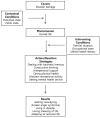Disaster Reintegration Model: A Qualitative Analysis on Developing Korean Disaster Mental Health Support Model
- PMID: 29463030
- PMCID: PMC5858431
- DOI: 10.3390/ijerph15020362
Disaster Reintegration Model: A Qualitative Analysis on Developing Korean Disaster Mental Health Support Model
Abstract
This study sought to describe the mental health problems experienced by Korean disaster survivors, using a qualitative research method to provide empirical resources for effective disaster mental health support in Korea. Participants were 16 adults or elderly adults who experienced one or more disasters at least 12 months ago recruited via theoretical sampling. Participants underwent in-depth individual interviews on their disaster experiences, which were recorded and transcribed for qualitative analysis, which followed Strauss and Corbin's (1998) Grounded theory. After open coding, participants' experiences were categorized into 130 codes, 43 sub-categories and 17 categories. The categories were further analyzed in a paradigm model, conditional model and the Disaster Reintegration Model, which proposed potentially effective mental health recovery strategies for disaster survivors, health providers and administrators. To provide effective assistance for mental health recovery of disaster survivors, both personal and public resilience should be promoted while considering both cultural and spiritual elements.
Keywords: disaster; mental health; posttraumatic stress disorder; psychological recovery; qualitative research.
Conflict of interest statement
The authors declare no conflict of interest.
Figures
Comment in
-
Comment on Choi, Y.-J.; Choi, H.-B.; O'Donnell, M. Disaster Reintegration Model: A Qualitative Analysis on Developing Korean Disaster Mental Health Support Model. Int. J. Environ. Res. Public Health 2018, 15, 362.Int J Environ Res Public Health. 2019 Aug 5;16(15):2789. doi: 10.3390/ijerph16152789. Int J Environ Res Public Health. 2019. PMID: 31387322 Free PMC article.
References
-
- Kim H.-S., Ahn J.-Y., Kim D.-I. Counselors’ consensus on response to national disaster -Experience of disaster counseling and needs of counselors- Korea J. Couns. 2015;16:495–512.
-
- Lee N., Sim K., Han S., Lee K., Sim M., Chae J., Ahn H. A qualitative content analysis of reports of mental health service providers after the Sewol Ferry Accident in Korea. Ment. Health Soc. Work. 2015;43:116–144.
-
- Choi Y.-J., Pang K.-Y., Kim S. A transcultural model of Hwa-Byung: A Grounded theory. J. Korean Acad. Psychiatr. Ment. Health Nurs. 2006;15:508–512.
-
- Choi T.-S., Kim J.-H., Lee D.-H. A systemic approach about psycho-social interventions programs on disasters and post-traumatic stress disorder: On cultural perspective. Korean J. Cult. Arts Educ. Stud. 2014;9:99–118. doi: 10.15815/kjcaes.2014.9.5.99. - DOI
Publication types
MeSH terms
LinkOut - more resources
Full Text Sources
Other Literature Sources
Medical





